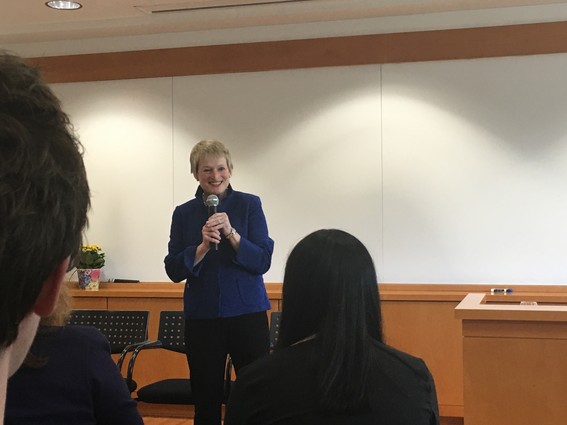Expect a "Tour of Duty" Employment Relationship with Tech Workers, McGrath Tells Einstein's Alley Audience

Speaking at an Einstein’s Alley meeting on the Future of Work in June, Rita Gunther McGrath, an American strategic management scholar and professor of management at Columbia Business School, provided strategies for tech companies to avoid stagnation.
She also warned human resources administrators in the audience about the new realities of a workforce that must constantly change.
“We are moving into what I’ll call a ‘tour of duty’ employment relationship,” she told the group. “We have done a fantastic job of teaching a whole generation that companies are not loyal. It would be fool hearted for them to expect otherwise.” She added, “Today’s work is much more like a contract.”
The meeting was held at Miele Appliances headquarters in Princeton, a building designed by architect Michael Graves. According to Katherine Kish, Einstein’s Alley executive director, the organization’s mission is to create a real ecosystem for innovation, creativity and entrepreneurship in New Jersey. “We like to look at big ideas in non-superficial ways,” she told the group.
In order to think about the future of work, you have to understand where organizations find themselves, McGrath said. Previously, businesses were structured around their industries and only had to look to competitors to figure out how they would act. However things have changed.
- The concept of having a permanent competitive advantage — an advantage that once created, lasts for a long time, can be planned and benchmarked around– has disappeared.
- That model is a trap for companies. If you think you are going to have an advantage that lasts for a long time, you are not going to be making the investments you need in innovation, in people, in upskilling the workforce, and in keeping on top of your technologies.
Companies must adopt a model of continuous reconfiguration. Most of us think that there will be some kind of big change and you’ll get past it and then things will settle down. When there is more disruption than stability, normal is really being in a state of continuous movement, she said.
- Some things will have to stay stable, such as your values and your core culture. “You have to build a system of dynamism and stability. Enough stability that you don’t drive people nuts. Enough change that you don’t get left behind.”
- However you change how you allocate resources. You change the new ideas you get exposed to. You change the diversity of people.
Organizations often struggle with healthy disengagement, she noted. A product takes off and has momentum and that’s great, and if you are lucky you have a while to exploit it, she said. However, technology changes, customers get bored, or everyone catches up with you. This thing is no longer going to drive a competitive advantage for you.
- You want to be able to pull resources out of that exhausted business, and repurpose them so you can start something new.
- The problem is that we don’t like to do this because we don’t like to see ends of things, she said.
- Companies don’t have disengagement processes in place. “They are not thinking of this as a natural part of the business cycle.”
Agile organizations have to think of innovation as a proficiency, she said.
- “You can’t talk about strategy without thinking about what you are going to do to generate the next generation of competitive advantage.”
- Most companies are good at “innovation theater.” They take some folks and send them to Silicon Valley and they get their picture with the Google sign, or they create innovation boot camps.
- The problem is you need more than ideation. Getting ideas is easy. The harder part is incubating those ideas into a concept that might have some business potential. You have to demonstrate a customer need and that you can fulfill it.
- Then you have to accelerate that to fruition. Here’s where things get tricky for HR. Most of the people who do the ideation and incubation of ideas—the people who do wireframes for example—are not the same people you want when you are accelerating or scaling the business.
- During ideation you want big thinkers, and people who have flashes of insights. During incubation you need the artists and the makers. For acceleration, you need people who will do exactly what they are supposed to do.

